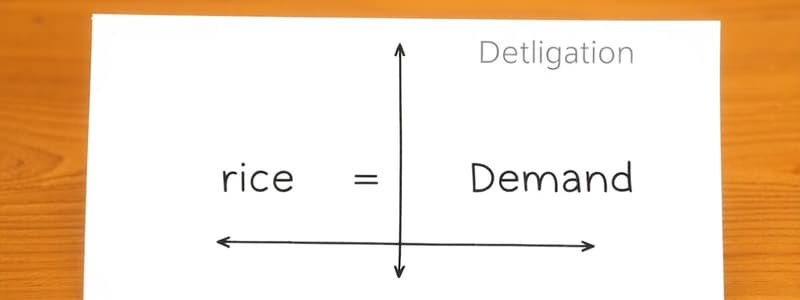Podcast
Questions and Answers
Why is understanding the shapes of supply and demand curves essential for economic analysis?
Why is understanding the shapes of supply and demand curves essential for economic analysis?
- They show how shocks affect equilibrium. (correct)
- They dictate the profitability of businesses.
- They determine the exact prices of goods and services.
- They allow governments to control market outcomes.
What does the price elasticity of demand measure?
What does the price elasticity of demand measure?
- The percentage change in quantity demanded in response to a given percentage change in price. (correct)
- The percentage change in price for a given percentage change in income.
- The change in quantity demanded for a given change in the supply.
- The change in price for a given change in quantity demanded.
If a 5% increase in the price of a good leads to a 15% decrease in the quantity demanded, what is the price elasticity of demand?
If a 5% increase in the price of a good leads to a 15% decrease in the quantity demanded, what is the price elasticity of demand?
- -3 (correct)
- 0.33
- 3
- -0.33
What defines a good with unitary elasticity of demand?
What defines a good with unitary elasticity of demand?
Consider a linear demand curve represented by the equation $Q = 20 - 2P$. What is the price elasticity of demand at a point where $P = 5$?
Consider a linear demand curve represented by the equation $Q = 20 - 2P$. What is the price elasticity of demand at a point where $P = 5$?
What distinguishes a perfectly elastic demand curve from a perfectly inelastic demand curve?
What distinguishes a perfectly elastic demand curve from a perfectly inelastic demand curve?
How does knowing whether demand for a product is elastic or inelastic help a business decide on pricing strategy?
How does knowing whether demand for a product is elastic or inelastic help a business decide on pricing strategy?
Why might the demand elasticity for a durable good like a car be different in the short run compared to the long run?
Why might the demand elasticity for a durable good like a car be different in the short run compared to the long run?
Considering airline travel in the U.S. which has an estimated price elasticity of -1.98, what pricing strategy would likely increase total revenue for airlines?
Considering airline travel in the U.S. which has an estimated price elasticity of -1.98, what pricing strategy would likely increase total revenue for airlines?
What does income elasticity of demand measure, and how is it useful in classifying goods?
What does income elasticity of demand measure, and how is it useful in classifying goods?
If a 2% increase in income leads to a 1% decrease in the quantity demanded for bus tickets, what type of good are bus tickets?
If a 2% increase in income leads to a 1% decrease in the quantity demanded for bus tickets, what type of good are bus tickets?
Assume the estimated demand function for avocados is $Q = 104 - 40p + 20p_t + 0.01Y$, calculate the income elasticity of demand for avocados when $Q = 80$, $Y = 4000$, where $p_t$ is the price of tomatoes.
Assume the estimated demand function for avocados is $Q = 104 - 40p + 20p_t + 0.01Y$, calculate the income elasticity of demand for avocados when $Q = 80$, $Y = 4000$, where $p_t$ is the price of tomatoes.
How does the cross-price elasticity of demand help in determining whether two goods are complements or substitutes?
How does the cross-price elasticity of demand help in determining whether two goods are complements or substitutes?
If a 10% increase in the price of coffee leads to a 5% increase in the quantity demanded of tea, are coffee and tea substitutes or complements, and what is the cross-price elasticity of demand?
If a 10% increase in the price of coffee leads to a 5% increase in the quantity demanded of tea, are coffee and tea substitutes or complements, and what is the cross-price elasticity of demand?
What does the elasticity of supply measure?
What does the elasticity of supply measure?
If a 1% increase in the price of wheat results in a 0.5% increase in the quantity supplied, what is the elasticity of supply for wheat?
If a 1% increase in the price of wheat results in a 0.5% increase in the quantity supplied, what is the elasticity of supply for wheat?
The estimated linear supply function for corn is $Q = 10.2 + 0.25p$. If the price of corn is $8.00 per bushel and the corresponding quantity supplied is 12.2 billion bushels per year, calculate the elasticity of supply.
The estimated linear supply function for corn is $Q = 10.2 + 0.25p$. If the price of corn is $8.00 per bushel and the corresponding quantity supplied is 12.2 billion bushels per year, calculate the elasticity of supply.
What is the effect of a specific tax collected from suppliers when the supply curve is perfectly elastic and the demand curve is downward sloping?
What is the effect of a specific tax collected from suppliers when the supply curve is perfectly elastic and the demand curve is downward sloping?
Under what conditions will consumers bear a larger portion of a sales tax than producers?
Under what conditions will consumers bear a larger portion of a sales tax than producers?
Flashcards
Elasticity
Elasticity
The percentage change in a variable in response to a given percentage change in another variable.
Price elasticity of demand
Price elasticity of demand
The percentage change in quantity demanded in response to a percentage change in price.
Relative elasticity of demand
Relative elasticity of demand
Demand is relatively elastic when |Ep| > 1
Relative inelasticity of demand
Relative inelasticity of demand
Signup and view all the flashcards
Unitary elasticity of demand
Unitary elasticity of demand
Signup and view all the flashcards
Perfect elasticity
Perfect elasticity
Signup and view all the flashcards
Perfect inelasticity
Perfect inelasticity
Signup and view all the flashcards
Essential goods
Essential goods
Signup and view all the flashcards
Income elasticity of demand
Income elasticity of demand
Signup and view all the flashcards
Cross-price elasticity and complements
Cross-price elasticity and complements
Signup and view all the flashcards
Cross-price elasticity and substitutes
Cross-price elasticity and substitutes
Signup and view all the flashcards
Substitute Goods
Substitute Goods
Signup and view all the flashcards
Complementary goods
Complementary goods
Signup and view all the flashcards
Elasticity of supply
Elasticity of supply
Signup and view all the flashcards
Ad valorem tax
Ad valorem tax
Signup and view all the flashcards
Specific tax (or unit tax)
Specific tax (or unit tax)
Signup and view all the flashcards
Tax incidence on consumers
Tax incidence on consumers
Signup and view all the flashcards
Supply Elasticities Over Time
Supply Elasticities Over Time
Signup and view all the flashcards
Study Notes
How Shapes of Supply and Demand Curves Matter
- Shapes of supply and demand curves dictate a shock's effect on equilibrium price and quantity.
- The supply of avocados is contingent on the price of avocados and fertilizer costs.
- Fertilizer is a major input in avocado production.
- An increase in fertilizer prices shifts the avocado supply curve leftward.
- The impact on equilibrium price/quantity depends on the demand curve's shape.
Sensitivity of Quantity Demanded to Price
- Knowing how much quantity demanded falls as the price increases is important in predicting the effect of a shock in a supply and demand model.
- Elasticity is the percentage change in one variable responding to a percentage change in another.
- Price elasticity of demand (ε) is the percentage change in quantity demanded, given percentage change in price, at a point on the demand curve.
- Formally, ε = (%ΔQ/%Δp) = (ΔQ/Q) / (Δp/p) = (ΔQ/Δp) * (p/Q), where Δ signifies change.
- Example: A 1% increase in price leads to a 3% decrease in quantity demanded; the elasticity of demand is e = -3%/1% = -3.
- Along a linear demand curve, given Q = a - bp, then -b is the ratio of fall in quantity to the rise in price: -b = ΔQ/Δp.
- Elasticity of demand = ε = (ΔQ/Δp) * (p/Q) = -b(p/Q).
- Categories of elasticity include relative elasticity (|Ep| > 1), relative inelasticity (0 < |Ep| < 1), and unitary elasticity (|Ep| = 1).
- Extreme cases are perfect elasticity (|Ep| = ∞) and perfect inelasticity (|Ep| = 0).
- Estimated demand curve for U.S. corn is Q = 15.6 - 0.5p, where Q is quantity in billion bushels/year, p is price in dollars/bushel.
- To find elasticity of demand at p = $7.20 per bushel: Substitute b, p, Q (where Q = 12) into the elasticity equation.
- Elasticity of demand at this point is ε = -b(p/Q) = -0.5 * (7.20/12) = -0.3.
- Elasticity of demand varies along most demand curves and is different at every point along a downward-sloping linear demand curve.
- Elasticities are constant along horizontal and vertical linear demand curves.
- Along a horizontal demand curve (perfectly elastic demand), elasticity is infinite, people are willing to buy at any price less than or equal to p*.
- If the price increases even slightly above p*, demand falls to zero.
- A small increase in price equals an infinite drop in quantity demanded along a horizontal demand curve.
- Along a vertical demand curve, elasticity is zero, which equals perfectly inelastic demand.
- If the price goes up, the quantity demanded is unchanged with perfectly inelastic demand.
- A demand curve is vertical for essential goods that people feel they must have and will pay anything to get.
- A diabetic's demand curve for insulin is perfectly inelastic below p* and perfectly elastic at p*, which is the maximum price the individual can afford to pay.
- A diabetic cannot afford to pay more than p*, and they buy nothing at higher prices.
- A diabetic's demand curve is perfectly elastic up to Q* units at a price of p*.
- Any shock that changes the equilibrium price will affect an industry's revenue.
- If revenue rises or falls when equilibrium price rises is determined by the elasticity of demand.
- With elastic demand, a higher price reduces revenue, and the opposite happens with inelastic demand.
Demand Elasticities Over Time
- Demand elasticities can vary between the short-run and long-run.
- The difference depends on substitution and storage opportunities.
- Elasticities for most goods tend to be larger in the long run.
- For easily storable or durable goods, the reverse is true:
- Coffee: short run is -0.2, long run is -0.33.
- Kitchen and household appliances: -0.63
- Meals at restaurants are at -2.27
- Airline travel in the US equals -1.98
- U.S. oil demand: short run is -.06, long run is -0.45.
Other Elasticities
- Income elasticity measures the percentage change in quantity given percentage change in income.
- Formally, ε = (%ΔQ/%ΔY) = (ΔQ/Q)/(ΔY/Y) = (ΔQ/ΔY) * (Y/Q), where Y stands for income.
- Example: A 1% increase in income leads to a 3% increase in quantity demanded, the income elasticity of demand is x = 3%/1% = 3.
- There are three situations relating to income elasticity of demand, quantity demanded of the product increases as income rises, indicating a positive income elasticity of demand and thus a normal good.
- As income rises, the quantity demanded of the product remains unchanged and the income elasticity of demand is equal to zero.
- The quantity demanded decreases as income rises, thus illustrating negative income elasticity of demand and an inferior good.
- Treating children as a consumption good finds that its income elasticity is negative yet close to zero.
- Number of children demanded is not very sensitive to income.
- The estimated demand function for avocados is Q = 104 - 40p + 20pt + 0.01Y.
- The quantity is measured in millions of lbs/month, avocado and tomato prices in dollars/lb, and average monthly income in dollars.
- Cross-price elasticity considers the effects on the quantity of one product given the changing price of another.
- Formally: (%ΔQ/%Δpo) = (ΔQ/Q) / (Δpo/po) = (ΔQ/Δpo) * (po/Q), where po is the price of another good.
- Example: A 1% increase in the price of a related good results in a 3% decrease in quantity demanded, the cross-price elasticity of demand is = -3%/1% = -3.
- If cross-price elasticity is negative, goods are considered complements.
- If the cross-price elasticity is positive, goods are substitute.
- Ex > 0: Increasing the iPhone X price leads to increase in quantity demanded for Samsung S11; a substitution effect occurs.
- Ex = 0: Increasing the iPhone price leads to no changes in quantity demanded of Lamb Doner, which are unrelated goods.
- Ex 0.5 (in absolute value).
- The estimated demand function for avocados is Q = 104 - 40p + 20pt + 0.01Y.
Sensitivity of Quantity Supplied to Price
- Elasticity of supply is similar to demand, but considers how much supply changes with price.
- Formally, η = (%ΔQ/%Δp) = (ΔQ/Q) / (Δp/p) = (ΔQ/Δp) * (p/Q), Q= quantity supplied.
- A 1% increase in price results in a 2% increase in quantity supplied, the elasticity of supply is η = 2%/1% = 2.
- Along a linear supply curve Q = g + hp, h is the slope or h = ΔQ/Δp.
- The elasticity of supply is η = (ΔQ/Δp) * (p/Q) = h*(p/Q).
- Estimated function for corn = Q = 10.2 + 0.25p.
- Q is quantity of corn supplied in billion bushels per year and p is the price of corn in dollars per bushel.
- If p = $7.20 and Q = 12, the elasticity of supply is: η = (ΔQ/Δp) * (p/Q) = 0.25 * (7.20/12) = 0.15.
- Supply elasticities may differ in the short-run and the long-run depending on the ability to convert fixed inputs into variable inputs.
- Firms' long-run supply elasticity is generally greater than short-run elasticity.
Effects of a Sales Tax
- Sales taxes affect equilibrium prices and quantity as well as tax revenue.
- Equilibrium price and quantity do not depened on whether the government collects a specific tax from the suppliers or their customers.
- Producers dont paass along to customers any taxes collected from producers, that is, do consumers pay the entire tax?
- Comparable ad valorem and specific taxes does not have equivalent effects on equilibrium prices and quantities and on tax revenue.
- An ad valorem tax is for every dollar the consumer spends, and the government keeps a fraction, a, which is the ad valorem tax rate.
- A specific tax (or unit tax) is where a specified dollar amount, t, is collected per unit of output.
- If the government sets a new specific tax of t and raises the tax from 0 to t, so the change in the tax is At = t - 0 = t.
- The incidence of a tax on consumers is the share of the tax that consumers pay.
- Incidence of the tax that falls on consumers is Δp/Δt, the amount by which the price to consumers rises as a fraction of amount tax increases.
- Tax incidence on customers depends on the elasticities of supply and demand.
- Price customers pay increases by Δp = (η/(η-ε))Δt.
- If ε = -0.3 and η = 0.15, a change of a tax of Δt = $2.40 causes the price buyers pay to rise by Δp = (η/(η-ε))Δt = (0.15/(0.15−[-0.3])) * $2.40 = 80¢.
- The incidence of tax that consumers pay = Δp/Δt = η/(η-ε).
- The incidence of the corn tax on consumers = 0.15/.15−[−0.3] =1/3.
Studying That Suits You
Use AI to generate personalized quizzes and flashcards to suit your learning preferences.



